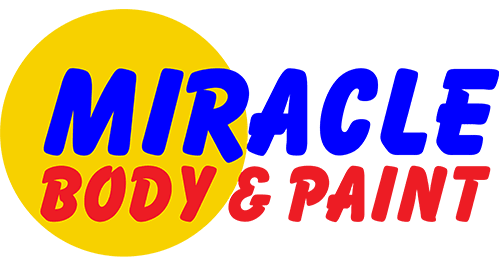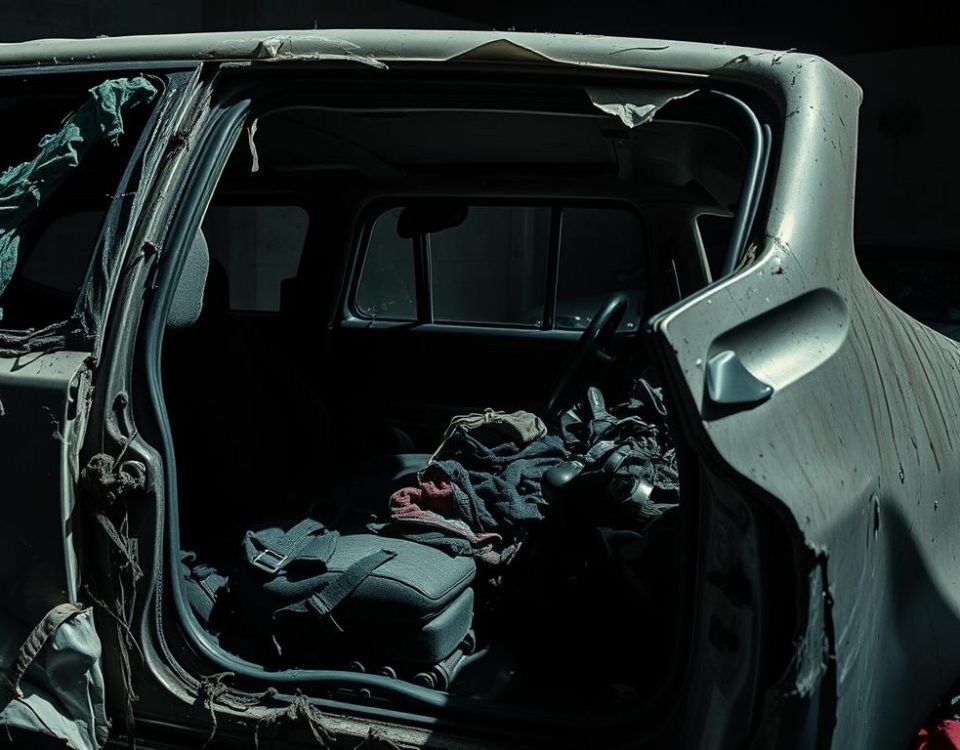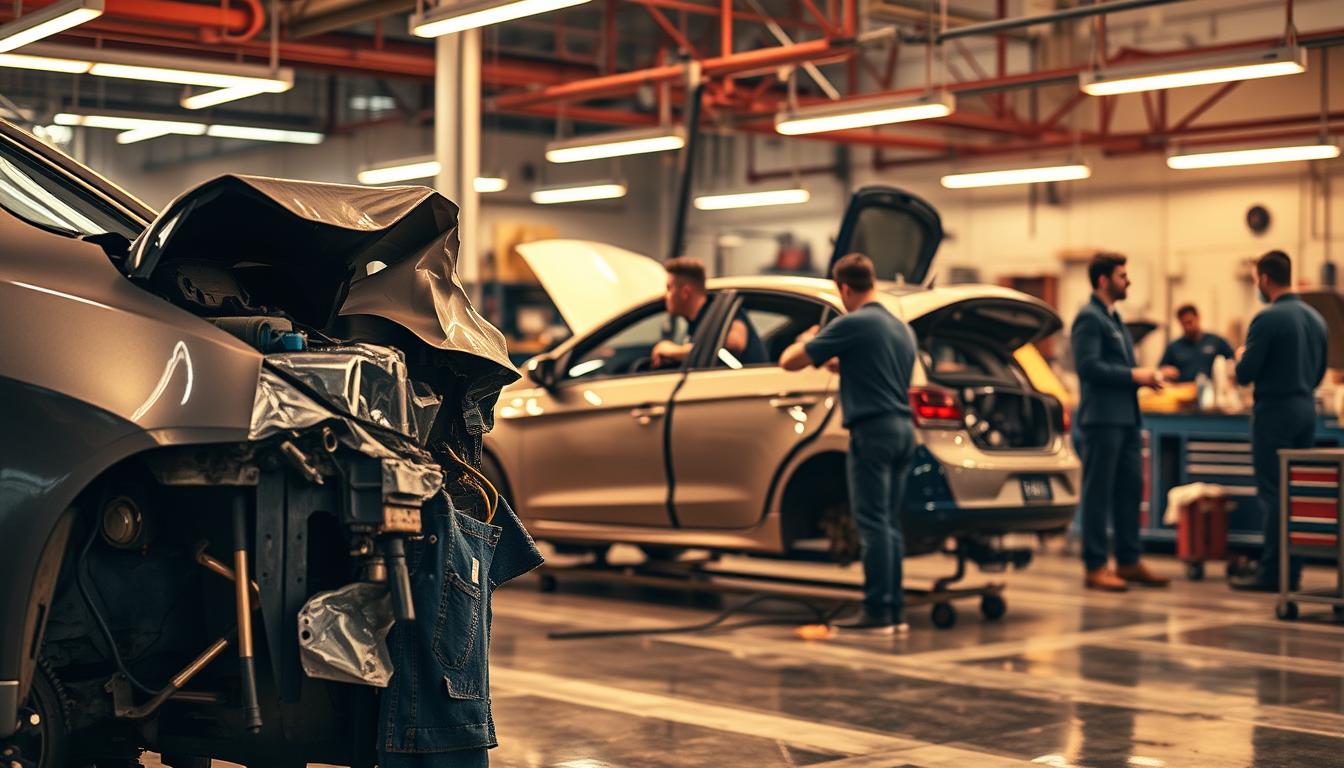
How Long Does Collision Repair Take?
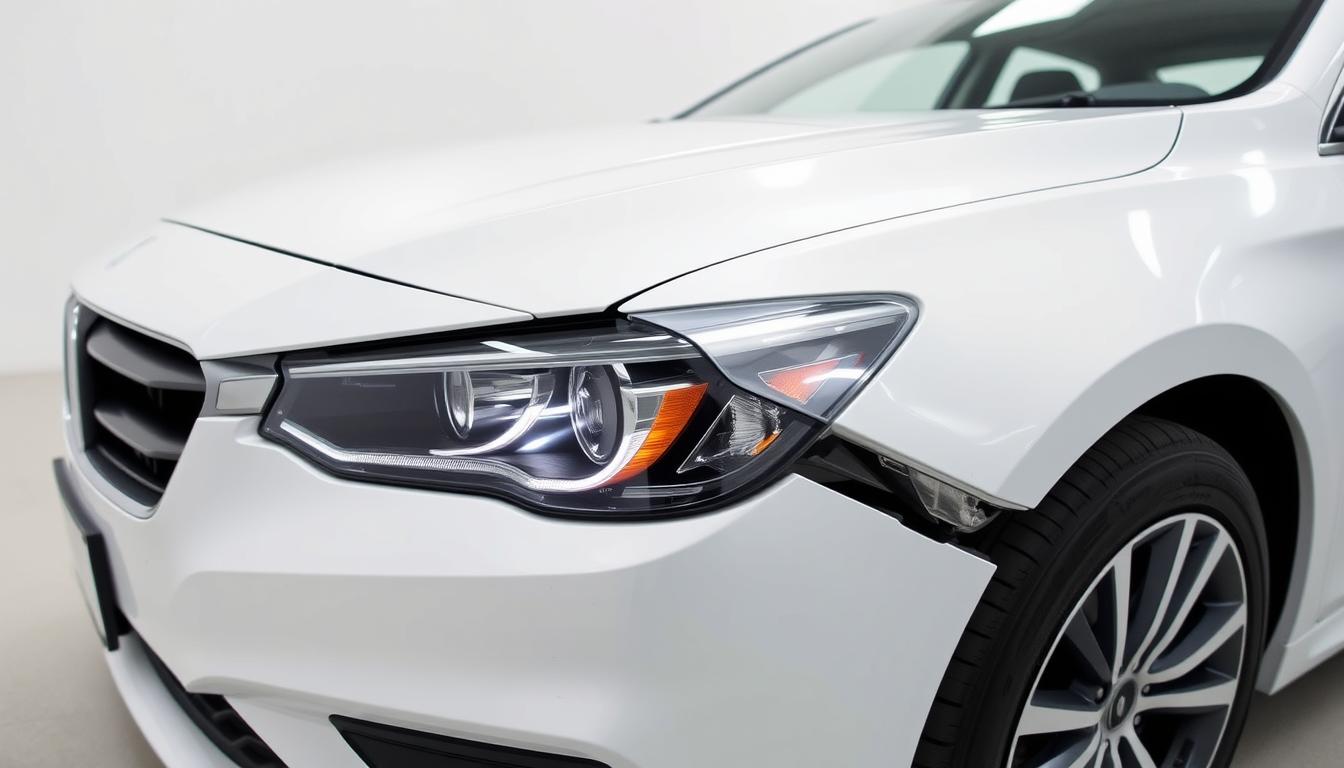
How Safe is Your Vehicle After Collision Repair?
Many car owners consider taking the DIY route for collision damage repairs to save money. However, DIY repair can often lead to more harm than good.
While the idea of saving money is tempting, DIY auto body repair can result in additional damage to your vehicle, potentially leading to costly repairs down the line.
If you’re dealing with collision damage, it’s worth considering professional help. At Miracle Body and Paint, with locations in San Antonio, our experts can guide you through the repair process, ensuring your vehicle is restored to its original condition.
Key Takeaways
- DIY repairs can cause additional damage to your vehicle.
- Professional repair services can save you money in the long run.
- Expert technicians can ensure high-quality repairs.
- Consider the risks before attempting DIY auto body repair.
- Miracle Body and Paint offers professional collision damage repair services.
Understanding Auto Body Repair Basics
Auto body repair is a complex process that demands precision, expertise, and the right tools. Whether you’re dealing with a minor scratch or a major collision, understanding the basics is crucial for a successful DIY repair.
Modern vehicles are made with advanced materials and technologies, making repairs more challenging than ever. Proper preparation is key to avoiding costly mistakes and ensuring a professional finish.
Common Types of Auto Body Repairs
Auto body repairs can range from simple touch-ups to complex reconstructions. Some of the most common types of repairs include:
- Dent removal and paintless dent repair
- Scratch and scuff repair
- Rust repair and prevention
- Panel replacement and alignment
- Painting and refinishing
Each type of repair requires specific tools and techniques. Understanding the nature of the damage is essential for choosing the right approach.
Tools You’ll Need for DIY Repair
Having the right tools is essential for any DIY auto body repair project. Some of the basic tools you’ll need include:
- Basic hand tools like hammers, dollies, and files
- Specialized tools like dent removal kits and paint guns
- Safety equipment like gloves, goggles, and masks
Investing in quality tools may seem expensive upfront, but it pays off in the long run by ensuring better results and reducing the risk of injury.
Safety Precautions to Consider
Safety should always be your top priority when working on DIY auto body repairs. Some key safety precautions include:
- Wearing protective gear like gloves and goggles
- Working in a well-ventilated area to avoid inhaling fumes
- Using proper lifting techniques to avoid injury
- Following manufacturer instructions for chemicals and tools
By taking the necessary safety precautions, you can minimize risks and ensure a safe working environment.
Pros of DIY Auto Body Repair
With the right tools and knowledge, DIY auto body repair can be a cost-effective and flexible solution for minor repairs. Many car owners are drawn to the idea of fixing their vehicles themselves, not just to save money, but also to gain new skills.
Cost Savings Compared to Professional Services
One of the most significant advantages of DIY auto body repair is the potential for cost savings. By taking on the repair work yourself, you can avoid labor costs associated with professional auto body shops. Here are some key areas where you can save:
- Labor costs: By doing the work yourself, you eliminate the need to pay for someone else’s time.
- Parts markup: Buying parts directly can be cheaper than purchasing them through a repair shop.
- Flexibility in sourcing: You can shop around for the best deals on parts and materials.
Flexibility in Scheduling Your Repairs
DIY auto body repair also offers the advantage of flexibility in scheduling. Unlike professional repair shops that may have limited availability, you can work on your vehicle at your own pace and on your own schedule. This is particularly beneficial for those with busy lifestyles or who prefer to work on their projects over weekends.
Learning New Skills and Techniques
Engaging in DIY auto body repair is not just about fixing your car; it’s also about learning new skills. Through this process, you can gain hands-on experience and develop a deeper understanding of automotive repair. This knowledge can be empowering and potentially save you money on future repairs.
In conclusion, while there are valid concerns about DIY auto body repair, the benefits of cost savings, flexibility, and skill development make it an attractive option for many car owners. By understanding the pros and cons, you can make an informed decision that best suits your needs and capabilities.
Cons of DIY Auto Body Repair
While DIY auto body repair can be cost-effective, it comes with its own set of challenges. Understanding these challenges is crucial for making an informed decision about whether to proceed with DIY repairs or seek professional help.
Potential for Incomplete Repairs
One of the significant drawbacks of DIY auto body repair is the potential for incomplete repairs. Without the proper training and experience, it’s easy to overlook critical steps or not fully address the damage, leading to further issues down the line.
For instance, in the case of collision damage, if the repair is not done correctly, it can lead to structural weaknesses or rust issues if not properly treated.
Time Commitment and Effort Required
DIY auto body repair requires a significant time commitment and effort. Unlike professionals who have the necessary tools and experience, individuals may find themselves spending hours researching, gathering materials, and executing the repairs.
- Researching the correct techniques and materials
- Acquiring the necessary tools and parts
- Executing the repair, which can be physically demanding
Risks of Inexperience or Mistakes
The risks associated with inexperience or mistakes in DIY auto body repair cannot be overstated. Inexperience can lead to a myriad of problems, from improper paint application to incorrect structural repairs, potentially causing more harm to the vehicle.
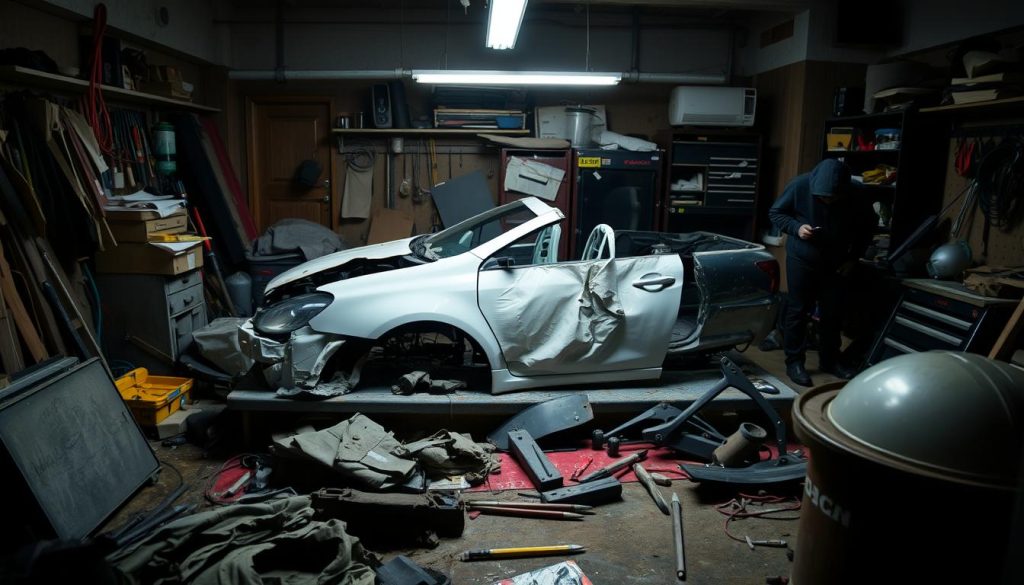
Assessing Your Repair Needs
Understanding the extent of the damage and your capability to repair it is essential for a successful DIY auto body repair project. Before you begin, it’s vital to take a step back and assess the situation thoroughly.
Identifying Damage: Minor vs. Major
The first step in assessing your repair needs is to identify the extent of the damage. Minor damages might include small dents, scratches, or minor rust spots. These are typically superficial and can be addressed with basic DIY tools and techniques. On the other hand, major damages involve significant structural issues, such as large dents, deep scratches, or extensive rust damage that compromises the vehicle’s integrity.
Minor damage can often be repaired with simple tools and techniques, making it a good starting point for DIY enthusiasts. However, major damage requires more extensive repairs, potentially involving specialized tools and expertise.
Evaluating Your Skill Level
It’s equally important to evaluate your skill level honestly. DIY auto body repair requires a certain level of mechanical aptitude, patience, and attention to detail. If you’re new to DIY repairs, starting with minor projects can help you build the necessary skills. Consider your experience with similar projects and whether you have the time and resources to dedicate to the repair.
- Assess your experience with DIY projects.
- Consider the complexity of the repair.
- Evaluate the time you can dedicate to the project.
When to Seek Professional Help
Knowing when to seek professional help is crucial. If the damage is extensive or you’re unsure about how to proceed, it’s best to consult a professional. Professionals have the training, experience, and equipment to handle complex repairs, ensuring that your vehicle is restored to a safe and reliable condition.
If you identify any of the following, it’s likely time to seek professional help: significant structural damage, uncertainty about the repair process, or a lack of necessary tools and expertise.
Essential Tools for DIY Auto Body Repair
To tackle DIY auto body repair, you’ll need to assemble a collection of essential tools. Having the right tools is essential for any repair, and professional-grade tools can be costly and require expertise to use effectively.
Basic Hand Tools for Beginners
For beginners, starting with basic hand tools is a good idea. These include pliers, screwdrivers, wrenches, and hammers. These tools are versatile and can be used for a variety of tasks, from removing damaged parts to applying repairs.
A good set of socket wrenches and Torx drivers can help with tasks that require more precision. It’s also useful to have a multitool on hand for unexpected tasks.
Specialized Equipment and Their Uses
As you progress in your DIY auto body repair journey, you may need to invest in specialized equipment. Tools like dent pullers and welding equipment can be invaluable for specific repairs. A paint sprayer is also essential for achieving a smooth, professional finish.
For more complex repairs, consider investing in a frame straightener or a hydraulic press. These tools can help you tackle challenging projects with confidence.
Where to Source Affordable Tools
Sourcing affordable tools is crucial for DIY enthusiasts on a budget. Consider shopping at local hardware stores or online marketplaces like Amazon or eBay. You can also look for discounts and sales at auto parts suppliers.
Another option is to borrow tools from friends or family members, or to rent specialized equipment for specific projects. This can help reduce costs and ensure you have the right tools for the job.
By assembling the right tools and resources, you can tackle DIY auto body repair projects with confidence and achieve professional-like results.
Popular DIY Repair Techniques
For those venturing into DIY auto body repair, understanding the various techniques available is crucial. This knowledge not only helps in achieving professional-looking results but also ensures the longevity of the repair. In this section, we will explore some of the most popular DIY repair techniques, including painting and touch-ups, dent removal, and rust repair and prevention methods.
Painting and Touch-Ups
Painting and touch-ups are among the most common DIY auto body repair techniques. To achieve a seamless finish, it’s essential to match the paint color accurately and apply it under the right conditions. Start by cleaning the area thoroughly, then sand it to create a smooth surface. Apply a primer if necessary, followed by the paint, using light coats to avoid drips.
Dent Removal Techniques
Dent removal is another technique that can be done at home with the right tools. Techniques include using a dent puller for minor dents or more complex methods like hot glue and a pulling tool for deeper dents. It’s crucial to assess the dent’s depth and location before choosing a method to avoid further damage.
Rust Repair and Prevention Methods
Rust repair and prevention are critical for maintaining the integrity of your vehicle’s body. Start by removing the rust completely, then treat the area with a rust converter. For prevention, regularly wax your vehicle and inspect for any signs of rust, especially in areas prone to moisture.
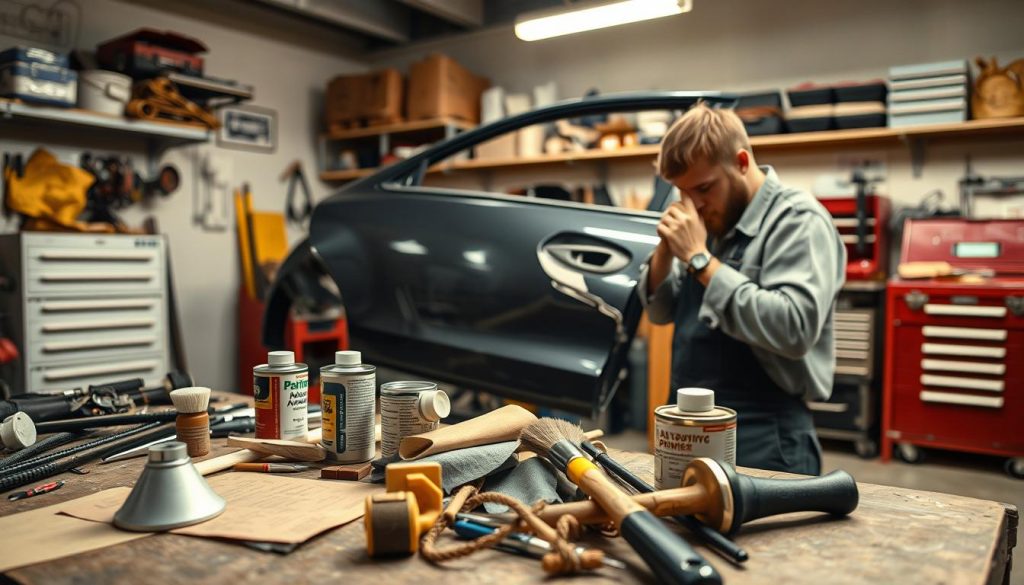
By mastering these DIY repair techniques, vehicle owners can not only save money but also gain a sense of accomplishment. Whether it’s a simple touch-up or a more complex repair, the right techniques and a bit of patience can make all the difference.
DIY Repair Kits: Are They Worth It?
DIY repair kits are a convenient solution for auto body repairs, but are they reliable? For many car owners, the prospect of saving money on auto body repairs is enticing, and DIY repair kits seem like an attractive option.
These kits are designed to help individuals fix common issues such as dents, scratches, and rust spots without needing professional help. However, the effectiveness of these kits can vary widely depending on the type of repair and the quality of the kit.
Overview of Common DIY Auto Repair Kits
DIY auto repair kits come in various forms, each designed for specific types of repairs. Some kits are specialized for dent removal, while others are geared towards rust repair or painting and touch-ups.
Common types of DIY repair kits include:
- Dent removal kits, which often include specialized tools for pulling out dents without damaging the paint.
- Rust repair kits, which typically contain chemicals for removing rust and materials for patching up damaged areas.
- Paint touch-up kits, designed to help car owners match and apply paint to scratched or damaged areas.
Pros and Cons of Using Repair Kits
Using DIY repair kits can have several advantages, including cost savings and the convenience of being able to do repairs at home. However, there are also potential downsides to consider.
The pros of DIY repair kits include:
- Cost savings compared to hiring a professional.
- The ability to do repairs at your own pace.
- A sense of accomplishment from completing the repairs yourself.
The cons include:
- The potential for incomplete or improper repairs if the kit is not used correctly.
- Limited effectiveness for more complex or extensive repairs.
- The risk of using low-quality materials that may not last.
Evaluating Kit Quality and Effectiveness
To get the most out of a DIY repair kit, it’s crucial to evaluate its quality and effectiveness before making a purchase. Look for kits from reputable manufacturers that include high-quality materials and clear instructions.
When evaluating a DIY repair kit, consider the following factors:
- The type of repair the kit is designed for and whether it matches your needs.
- The quality of the materials included in the kit.
- Reviews and feedback from other users to gauge the kit’s effectiveness.
By carefully selecting a DIY repair kit and following the instructions provided, car owners can successfully complete a variety of auto body repairs at home.
Building a DIY Auto Body Repair Community
A strong DIY community can provide invaluable support and guidance for individuals undertaking auto body repair. By connecting with others who share similar interests and challenges, DIY enthusiasts can gain insights, learn new techniques, and stay motivated throughout their projects.
Online Forums and Resources
Online forums are a treasure trove of information for DIY auto body repair enthusiasts. Websites and social media groups dedicated to automotive repair offer a platform to ask questions, share experiences, and learn from others. Some popular online resources include forums on Reddit, specialized automotive repair websites, and YouTube channels focused on DIY repairs.
These online communities are not only informative but also provide a space to connect with others who have faced similar challenges, making the repair process less isolating.
Local Workshops and Classes
In addition to online resources, local workshops and classes can offer hands-on experience and personalized instruction. Many community colleges, vocational schools, and local automotive shops provide classes or workshops on auto body repair techniques.
Participating in these local events can be a great way to gain practical skills, ask questions, and network with other DIY enthusiasts and professionals in the field.
Sharing Tips and Experiences with Others
One of the most rewarding aspects of being part of a DIY auto body repair community is the opportunity to share tips and experiences with others. Whether through online forums, social media, or local meetups, sharing your knowledge can help others avoid common pitfalls and achieve their repair goals.
Moreover, sharing your experiences can also help you reflect on your own learning process, solidifying your understanding of the techniques and methods you’ve employed.
Final Thoughts on DIY Auto Body Repair
When considering DIY auto body repair, it’s essential to balance cost, time, and skill. While taking on repairs yourself can be cost-effective, it’s crucial to evaluate your skill level and the time required for the job.
Weighing Your Options
DIY auto body repair can be a viable option for minor repairs, but more extensive damage may require professional assistance. Assessing the cost of materials, your time, and the potential risks of inexperience is vital.
Professional Help When Needed
If you’re unsure about tackling a repair, seeking professional help can be the most cost-effective and safe decision in the long run. For collision repair damage, consider consulting a reputable service like Miracle Body and Paint, with locations in San Antonio.
Empowering DIY Enthusiasts
For those confident in their DIY skills, online resources and local workshops can provide valuable guidance. By making informed decisions and being aware of your limitations, you can successfully navigate DIY auto body repair.
For complex repairs or to ensure a flawless finish, visit Miracle Body and Paint for expert assistance.

